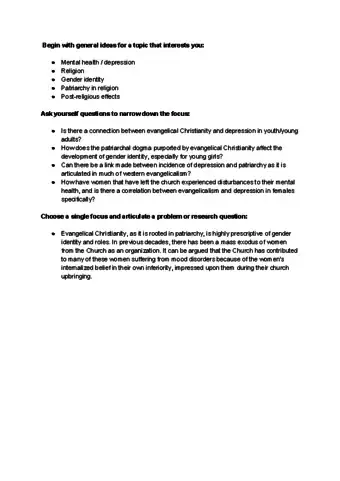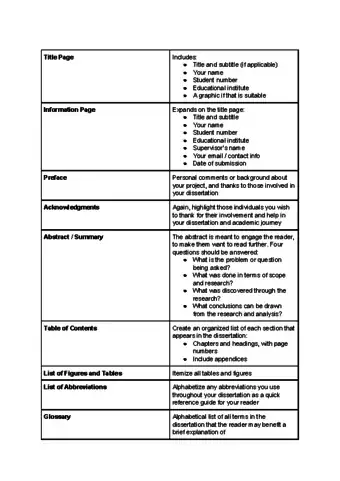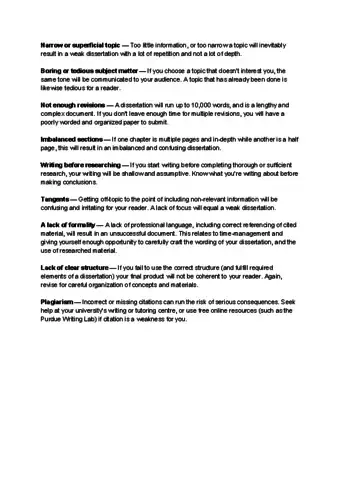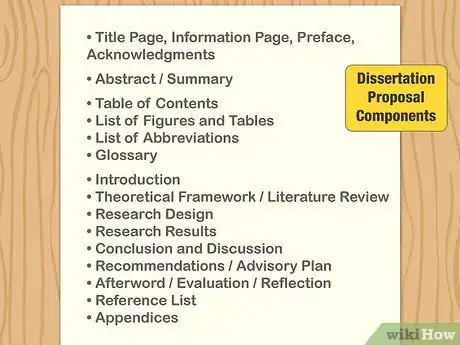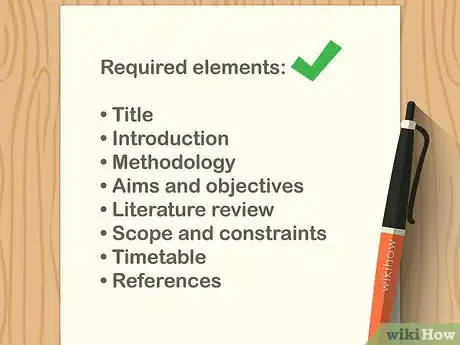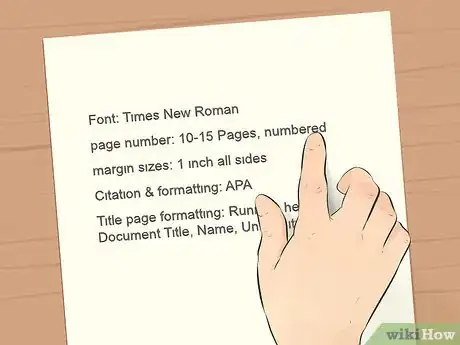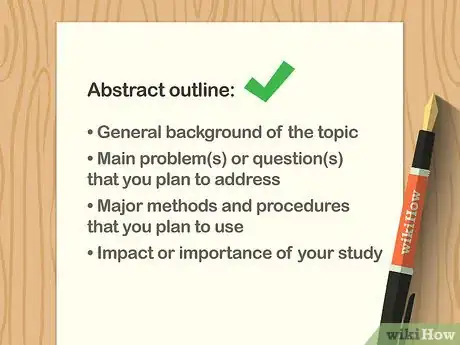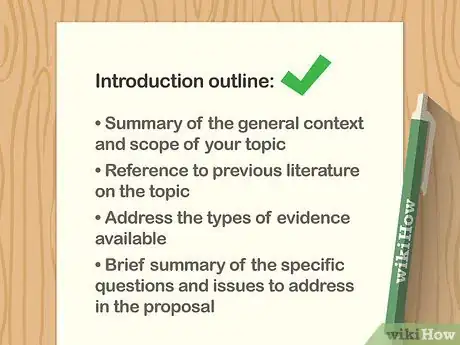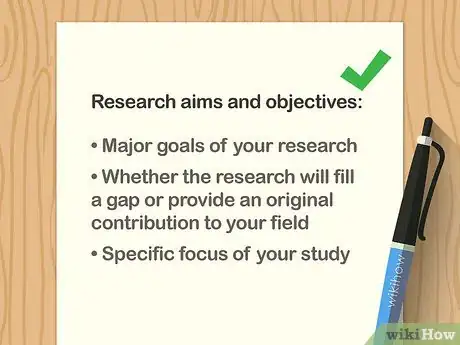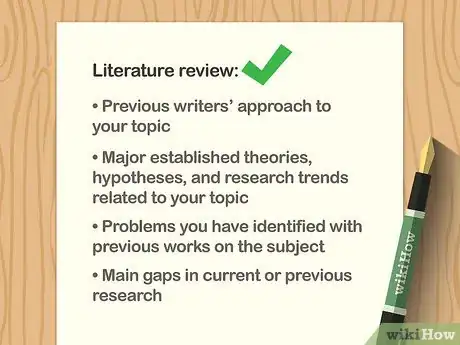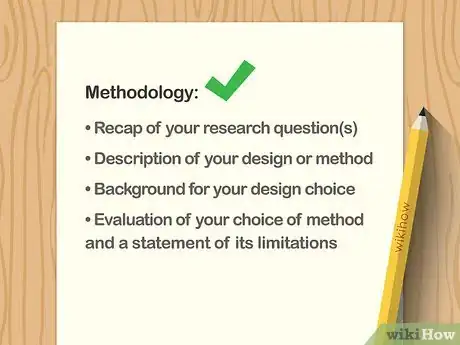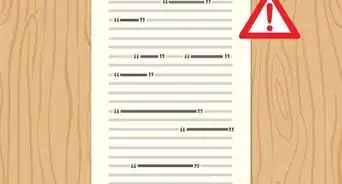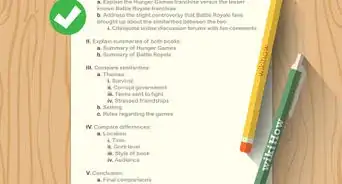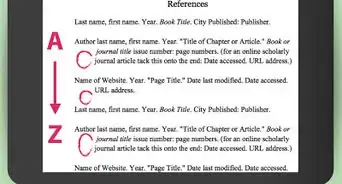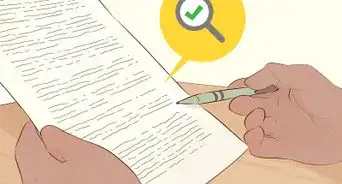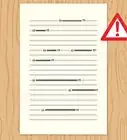This article was co-authored by Christopher Taylor, PhD and by wikiHow staff writer, Megaera Lorenz, PhD. Christopher Taylor is an Adjunct Assistant Professor of English at Austin Community College in Texas. He received his PhD in English Literature and Medieval Studies from the University of Texas at Austin in 2014.
wikiHow marks an article as reader-approved once it receives enough positive feedback. In this case, 89% of readers who voted found the article helpful, earning it our reader-approved status.
This article has been viewed 91,326 times.
A dissertation proposal is a brief overview of the aims and significance of your dissertation research. The aim of the proposal is to demonstrate to your dissertation committee that your dissertation will represent an original and beneficial contribution to your field. The requirements for writing a dissertation proposal vary from one PhD or doctoral program to another, so you will need to start by checking with your department to find out about their specific rules. Work with your advisor to pick a suitable topic, and then write a well-organized proposal based on your preliminary research.
Steps
Writing Help
Following Departmental Guidelines
-
1Write your proposal within the required timeline. Before you start your program, find out how much time you have to work on developing your dissertation topic. Every graduate program is different. You may need to start working on your proposal right away, or you might have to get a few years of coursework and some comprehensive exams out of the way first.
- Most graduate programs list their rules and timelines on the department website. If you’re not sure where to find this information, check with your advisor, the department chair, or your department’s administrative assistant.
-
2Conform to your program’s proposal length guidelines. The length of your dissertation proposal may vary depending on your program’s rules or the nature of your specific research. Most dissertation proposals are about 10-15 pages long, however.
- Some proposals may be 20 or more pages in length. Ask your advisor or check your departmental guidelines to find out what is appropriate for your proposal.
- Your program may present length guidelines in terms of word count instead of page length.[1]
- If there is no clear length requirement, talk with your advisor to find out what they recommend.
Advertisement -
3Structure your proposal as recommended by the guidelines. Some departments may provide specific guidelines for how to structure the content of your proposal, such as what to include in the proposal and how to order it. Follow these guidelines if they are available, or check with your advisor to find out what they suggest. Required elements of a dissertation proposal may include:[2]
- Title
- Introduction
- Methodology
- Aims and objectives
- Literature review
- Scope and constraints
- Timetable
- References
-
4Format your proposal according to your program’s requirements. Formatting requirements may also vary depending on your field and your program.[3] For example, review your program’s rules to find out if there are any special requirements regarding:
- Fonts, page numbers, and margin sizes.
- Citation style and formatting for notes and bibliography.
- Formatting of title pages and cover sheets.
-
5Select your committee members. Early in the dissertation writing process, you will need to select a dissertation committee. The committee typically consists of your academic advisor, 1-2 additional faculty members from your department, and an outside reader from another institution. Your committee members will review your proposal and work with you during the research and writing process.
- Most departments have requirements about who is eligible to serve on a dissertation committee. For example, your committee members may need to be selected from faculty who teach graduate level classes.
- Try to select committee members who have some familiarity with, and interest in, the topic you want to write about. If there are 2 faculty members who you think would be good fits, you may even consider asking them to be co-advisors.
-
6Follow your program’s approval process. Completing your proposal and getting it approved will probably involve dealing with some red tape. Check with your advisor or your department’s administrative office to find out what practical steps you need to take as you go through the process. For example, you may need to:
- Get a form signed by your committee chair or academic advisor approving your selected topic.
- Have your finished proposal approved and signed by each member of your committee.
- Coordinate with your department to set a date for a proposal hearing, if that is part of your program’s process.
Selecting Your Topic
-
1Make a list of topics that interest you. If you are starting an advanced graduate program, you probably already have a sense of what interests you in your field. Think about unanswered questions that came up in past reading or coursework that piqued your curiosity, and write down a few ideas.[4]
- Some things you might consider as you think about topics include classes taught by professors with whom you have a good working relationship, questions/holes in your research that you’d like to investigate further, and seminar or research papers you have written for your classes.
- For example, say you are studying animal behavior with a focus on mollusks. Perhaps you have noticed that there is not a lot of published information about the reproductive habits of the lesser Fauxlandian howling snail. This could be a good starting point for your research.
-
2Do some preliminary research on your topic(s). Once you’ve picked a few possible topics, do a literature search and some more in-depth reading. This will not only help familiarize you with each potential topic, but it will also give you a better idea of whether there is really a need for more research on that topic.[5]
- Check academic journals in your field for recent articles on your topic, and try to find out if there are any major monographs, peer reviewed articles, and/or book chapters dealing with the subject. Consider whether these sources are up-to-date, thorough, and methodologically sound.
- Use databases like ProQuest to find out if any other graduate students have recently done dissertations or theses on your potential topic(s).
-
3Talk to your advisor or committee chair about potential topics. Your academic advisor can help you decide whether your potential topic is feasible and appropriate or not. Set up an appointment to chat with them about topics you are interested in, but make sure to have a list of topic ideas ready before the meeting.
- If your advisor is familiar with the topic in question, they may be able to suggest a more specific angle or point you towards sources you weren’t familiar with.
- Be prepared to discuss more than 1 possible topic with your advisor. That way, if they don’t feel that your first choice will work, you will have something to fall back on.
-
4Narrow your focus once you have a general topic. After you and your advisor or committee chair agree on a topic, it’s time to get even more specific. Do some more in-depth reading and look at the aspects of your topic that merit a closer examination.
- For example, maybe your research shows that there’s new evidence regarding the role of shell color in howling snail mating rituals, but most current literature still reflects the outdated idea that howling snails select their mates based on eye-stalk length. This can help you narrow your topic from a general examination of howling snail reproductive habits to a study of mate selection based on shell color.
- Your focus may continue to narrow and evolve as you begin to research and write your dissertation in earnest, but that’s okay.[6] It’s better to start with a topic that’s too big than to begin writing and find that you don’t have enough material to work with.
Organizing and Writing Your Proposal
-
1Select a working title. The title of your dissertation should provide a brief and clear snapshot of the nature of your research. Developing a good working title early on can help orient and focus both you and your readers. However, keep in mind that you can continue to adjust your title as you continue to research and write.[7]
- Try to make your title as specific as possible. For example, instead of “A Study of Reproductive Selection in Lesser Fauxlandian Howling Snails,” try something like “An Empirical Examination of the Role of Shell Color in Mate Selection among Lesser Fauxlandian Howling Snails.”
-
2Write an abstract if your program requires it. An abstract is a brief summary of your proposal, usually 100-350 words long.[8] Your abstract should outline, in a few sentences:
- The general background of your topic.
- The main problem(s) or question(s) that you plan to address in your research.
- The major methods and procedures that you plan to use in order to answer your questions and/or support your thesis.
- The impact or importance of your study, also known as the “so what?” element of your project.
-
3Start with a general introduction to your topic. A good introduction should engage your readers’ interest and provide important context for understanding the rest of your proposal. Your introduction should:[9]
- Summarize the general context and scope of your topic.
- Briefly refer to previous literature on the topic and address the types of evidence available.
- Summarize, very briefly, the specific questions and issues you will address in your proposal.
-
4State the major problem your dissertation will address. In a paragraph or 2, write a concise “statement of the problem.” This is a brief summary of the knowledge gap you are hoping to fill with your research and what filling that gap may achieve. Depending on your topic and your program’s requirements, this may either be part of your introduction or a separate section.[10]
- For example, you might explain that recent research has shown that shell color plays a part in howling snail mate selection, but there are no current studies that adequately explain the specific color criteria for which the snails select.
-
5Explain your major research aims and objectives. This section of your proposal should discuss, in greater detail, which aspects of the problem you plan to explore. In a few short paragraphs, discuss:[11]
- The major goals of your research. I.e., what questions are you hoping to answer? Do you have any particular expectations about what you will find?
- How you believe your research will fill a gap or provide an original contribution to your field.
- The specific focus of your study, including which areas you are choosing NOT to address and why.
-
6Summarize previous literature on your topic. The literature review is an opportunity to demonstrate your familiarity with previous research on the subject and to show that your dissertation will be a unique contribution. You don’t have to offer an exhaustive list of all previous publications on your topic, but cover most of the key texts by other scholars.[12] Be sure to discuss:
- How previous writers have approached your topic (e.g., specific methodologies and arguments they have used).
- The major established theories, hypotheses, and research trends related to your topic.
- Any problems you have identified with previous works on the subject (e.g., they are too broad or limited in scope, outdated, or poorly supported).
- The main gaps in current or previous research, and which research needs still remain to be filled.
-
7Describe your methodology. The methodology section is a vital part of any dissertation proposal. This is where you will describe the nuts and bolts of how you plan to carry out your research and address the major problems and questions of your dissertation. The types of methodology you use will depend on your specific project and your field.[13]
- For example, if you are doing a science dissertation, you might break your methodology section down into discussion about selecting your subjects, designing your experiment, carrying out your experiment, and analyzing the results.
- Discuss any problems and limitations you anticipate. For example, you might point out that you expect to have trouble finding large sample sizes, which could make your results less statistically significant or harder to replicate than they would be if you had a bigger sample size.
-
8Demonstrate the significance of your research. Summarize the impact your research will have on your field, and how your contribution differs from previous work on the topic. In clear and straightforward terms, describe how you think your research will be useful or beneficial, both within and outside your field of study.[14]
- For example, perhaps you could argue that your work on mate selection in lesser Fauxlandian howling snails will have potential implications for scholarly understanding of reproductive behaviors in other types of mollusks.
-
9Outline your plan of action if your program requires it. Some programs may require you to include a timeline for completing the different phases of your dissertation. This may be particularly important for dissertations that involve designing and conducting experiments or carrying out field research.[15]
- Talk to your advisor about developing a realistic and attainable timeline for your dissertation.
- Be aware that your timeline may change as your work evolves and progresses—this is not meant to be a hard-and-fast schedule for completing your work.
- As you write your timeline, keep in mind practical considerations such as time needed for making travel arrangements or securing equipment for experiments or fieldwork.
-
10Present a list of your sources. Like any research paper, your dissertation proposal will need to include a full bibliography. Use an appropriate citation style for your field, and/or follow your program’s specific guidelines.[16]
- Depending on your topic or your program’s requirements, you may also need to include appendices or other supplemental material, such as diagrams, sample data collection forms, or permission forms (e.g. if you will be conducting experiments with human subjects).
Community Q&A
Did you know you can get answers researched by wikiHow Staff?
Unlock staff-researched answers by supporting wikiHow
-
QuestionHow long should a proposal be?
 wikiHow Staff EditorThis answer was written by one of our trained team of researchers who validated it for accuracy and comprehensiveness.
wikiHow Staff EditorThis answer was written by one of our trained team of researchers who validated it for accuracy and comprehensiveness.
Staff Answer wikiHow Staff EditorStaff Answer
wikiHow Staff EditorStaff Answer
References
- ↑ https://www.oxbridgeessays.com/blog/how-to-write-dissertation-proposal/
- ↑ https://learn.solent.ac.uk/mod/book/tool/print/index.php?id=2744
- ↑ https://www.oxbridgeessays.com/blog/how-to-write-dissertation-proposal/
- ↑ https://www.oxbridgeessays.com/blog/how-to-write-dissertation-proposal/
- ↑ https://www.oxbridgeessays.com/blog/how-to-write-dissertation-proposal/
- ↑ https://faculty.chass.ncsu.edu/garson/PA803/Dissertation_Proposal_Guide.pdf
- ↑ https://faculty.chass.ncsu.edu/garson/PA803/Dissertation_Proposal_Guide.pdf
- ↑ https://faculty.chass.ncsu.edu/garson/PA803/Dissertation_Proposal_Guide.pdf
- ↑ https://faculty.chass.ncsu.edu/garson/PA803/Dissertation_Proposal_Guide.pdf
- ↑ https://faculty.chass.ncsu.edu/garson/PA803/Dissertation_Proposal_Guide.pdf
- ↑ https://faculty.chass.ncsu.edu/garson/PA803/Dissertation_Proposal_Guide.pdf
- ↑ https://faculty.chass.ncsu.edu/garson/PA803/Dissertation_Proposal_Guide.pdf
- ↑ https://faculty.chass.ncsu.edu/garson/PA803/Dissertation_Proposal_Guide.pdf
- ↑ https://faculty.chass.ncsu.edu/garson/PA803/Dissertation_Proposal_Guide.pdf
- ↑ https://faculty.chass.ncsu.edu/garson/PA803/Dissertation_Proposal_Guide.pdf
- ↑ https://faculty.chass.ncsu.edu/garson/PA803/Dissertation_Proposal_Guide.pdf
- ↑ https://academicpositions.com/career-advice/phd-in-europe-or-the-us
About This Article
To write a dissertation proposal, keep in mind that the exact length and guidelines for your proposal may vary depending on your program's rules, so it's a good idea to check with your advisor if you're not sure. However, in general, your dissertation proposal should be 10-15 pages long. You'll also likely be required to include a title and introduction, as well as sections on your methodology, aims and objectives, literature review, scope and constraints, timetable, and references. For more advice from our Academic co-author, like how to choose a dissertation topic, scroll down!
